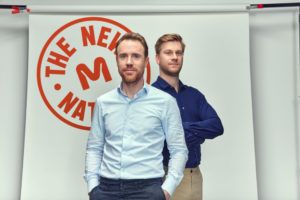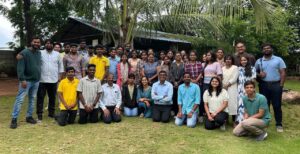Clever Carnivore—a Chicago-based cultivated meat startup that has stayed largely below the radar since it was formed in 2021—says it is producing cell culture media for just 7 cents a liter at pilot scale, and that a demo-scale plant costing $4.5 million could be “profitable in its first year of full production.”
Founded by stem cell biologist Dr. Paul Burridge and sociologist Dr. Virginia Rangos, Clever Carnivore is operating at pilot scale with two 500-liter bioreactors and a third on the way. It is currently raising capital to fund a demo-scale plant with 40,000-liters of capacity.
Its initial focus is non-GMO porcine cell lines that Burridge claims can double in under 14 hours in adherent culture (although they are grown at scale in liquid suspension) in low-cost proprietary bioreactors made by working directly with steel fabricators. The firm’s “low-cost, limited-ingredient” cell-culture media is made in-house and contains recombinant growth factors made on-site via microbial fermentation.
Clever Carnivore’s product has been tested in a wide range of foods including bratwurst, breakfast sausages, hotdogs and meatballs made with 10% cultivated cells and 90% plant-based meat.
‘Necessity is the mother of invention’
While some of the top-funded players in the cultivated meat space are seen to have overpromised and underdelivered with investor and media sentiment souring over the past couple of years, Clever Carnivore has been refining its tech on a shoestring budget, raising just $9 million to date, said Burridge.
“Necessity is the mother of invention. Ultimately our conscientious resource management has built a culture of science-first capital efficiency and has allowed us to focus on de-risking a platform that is ready to scale and will be profitable in a production plant.”
He added: “$0.07 per liter is our current real-world cost of our food-grade cell culture media. That’s what we’re paying today, including our in-house growth factor production, water purification and mixing. We anticipate further reductions as we scale to a production plant with a capacity of thousands of liters.
“It’s all about getting the fastest growing cells possible in media that supports the highest density possible at the lowest cost.”
In-house media production
The key to Clever Carnivore’s success has been a myoblast-derived cell type that is functionally immortal (it will continue to double ad infinitum but has not been spontaneously immortalized and is “focused on proliferation above all other attributes,” Burridge told AgFunderNews.
“We’re choosing not to modify the genome as we believe consumer acceptance for a GMO product, at least for the first generation of cultivated meat, is not there.”
He added: “Clever Carnivore has always had this concept of reciprocal optimization. So we make the media better, and then we make a new cell line, because our technology is not about spontaneous immortalization, which is kind of a random event. Ours is a very controllable and reproducible event, so we can keep making new lines in better media with more potent proteins.”
Asked what growth factors are in the media culture, he said: “That’s confidential. But how they’re optimized is a big part of the process. There are AI-based models enabling you to develop modifications to the amino acid sequence that make a protein more potent or more stable. We’ve been able to look at those kinds of technologies and develop our own proteins in house that can be used at very low concentrations. This is a big part of why our media is so cheap.”

First generation products
Asked whether it is important for cultivated meat cells to fully differentiate into multiple cell types (fat, muscle, connective tissue) and form fully-fledged tissue, he said, “There’s a middle ground. What we learned very quickly when we hired [chief product officer and Tyson Foods veteran] Russell Thomas is that for a first-generation product, a hybrid is the way to go [combining cultivated cells and plant-based or regular meat].
“We understand that there are companies out there that are focused on fat that say fat gives the flavor, but what we know with the cell type that we have is that it unquestionably adds to a hybrid product and gives it a better flavor, a better texture, and makes it more meaty.
“Whenever a guest comes to visit we do a comparison with a 100% plant-based product versus the Clever Carnivore bratwurst [containing a mix of cultivated cells and plant-based meat] and we have not had anyone ever say that they prefer the plant-based one. The question is, does it improve the product? And the answer is yes it does, consistently.”
And while Clever Carnivore is not making a structured product or engaging in tissue engineering, the product emerging from its bioreactors still “looks like pork,” he said. “It’s not a slurry or a beige paste.”
Bioreactor sweet spot
Clever Carnivore is looking at 5,000-L to 20,000-L bioreactors for its demo plant, which would be profitable in its first year of full production, said Burridge.
He added: “We’ve been working on technoeconomic analyses for two years now and we’re confident in our numbers.”
The larger the bioreactor, the less labor is involved, he noted. But once you go above 20,000 liters, new challenges present themselves: “A 20,000-liter bioreactor can fit in a 30-foot building like a warehouse. Anything much larger than that has to be built into a custom building. That’s the difference between being able to lease an existing building and having to have one custom made.
“And then the larger the reactor, there are challenges around the physics of moving liquids and shear stress [from propellers that stir the tanks but can damage cells]. And then there are questions about water supplies and wastewater treatment, so it all gets a lot more complicated.”
Tech ‘is viable, it will be profitable, and a number of companies will be successful’
Despite the doom and gloom currently surrounding the cultivated meat sector, he said, “As a scientist, I can tell you, it is viable, it will be profitable, and a number of companies will be successful. It’s just a matter of time. There is actually no great technology leap that has to be made. We essentially just need bigger equipment.”
As Clever Carnivore has had so little money to work with, he added, “Our only option has been to make it cheap, and I think that’s been to our advantage. We started with the price of a traditional sausage and worked back from that. We have to be profitable at cost parity because people will not pay a ‘green premium.’”
On the regulatory front, he said, conversations with the FDA are progressing as the firm prepares to submit its dossier. But with “no genetic modification and no components in the media that would raise questions,” it should be a “comparatively easy process,” he predicted.
The timetable is “dependent on the FDA,” he noted, “But we feel that we could have a saleable product that is also profitable in 18 months.”
‘In science you can’t just solve problems with money’
Stepping back to look at the cultivated meat space, he said, “It’s frustrating professionally to see that some of the heat has gone out of the field and people don’t seem to be ‘excited’ anymore as I can see that it is completely viable without any improvements from the level we have right now.”
With that in mind, he said, “I’m surprised by how slow progress has been [for some players] with the huge budgets that were available, although in science you can’t just solve problems with money. However, one could argue that the early companies started with comparatively primitive cell line technology whereas I think we had a much better cell line to start with.”
Structured products not quite ready for prime time
Structured products, however, will take more time to prove out, he claimed. “For companies funded by venture capital, you only have two or three or four years before you have to do the next round and the question is can you get some level of revenue in that time? In many cases, the answer is no. So we decided from the start to do ground pork products.
“I also think personally, when you think about a big beef steak, it’s a luxury item. If you go to a steakhouse, you’re going to want a traditional steak.”
Further reading:
GFI: There are ‘no silver bullets to fill funding gaps in cultivated meat’




